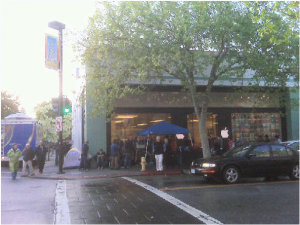April 19 is the anniversary of the Battle of Concord and Lexington in 1775, a minor military engagement that wound up having major political repercussions. Patrick Murfin has one of the best summaries of the events of that day that I’ve seen in a long time, and you should go check it out.
As someone who lived the first 42 years of his life mostly in Concord, and who worked for several years at the church on Lexington Green, it has been interesting to watch over the years as different political groups have tried to claim that the participants in the Battle of Concord and Lexington agreed with some narrow political ideology of the present day. In 1975, quasi-leftists staged a “people’s” celebration of the bicentennial of the battle, saying that the British colonials who presented armed resistance to His Majesty’s troops were in fact aligned with what was then called the New Left. More recently, right-wingers are wrapping themselves in quasi-colonial costumes, saying that the British colonials who presented armed resistance to His Majesty’s troops were in fact aligned with what is now called the “Tea Party” movement.
Both these claims, and all similar claims, have little to do with historical fact, and must be dismissed as silly. The 18th century men and women in the colonies of British North America inhabited a very different political and social world than we do in the early 21st century. Those 18th century men and women were colonials, subjects of the worldwide British empire. They were also subjects of an 18th century constitutional monarchy, and they owed allegiance to the person of King George. As colonials, they were subject to the laws promulgated by Parliament, yet they had no elected representation in Parliament. As colonials, whatever local government they had could be removed or replace by His Majesty’s government; in fact, that’s exactly what had happened, and the colonials had had essentially no political recourse when their elected officials were removed from office. Any recent citizen of the United States — and that includes the Tea Partyites and the old New Leftists — inhabits a very different political world than the colonials of British North America.
In my years living and working in Concord and Lexington, I saw plenty of political infighting; Lexington had a particularly nasty split between liberals and conservatives. But on April 19, we all tried to put aside our present-day politics. In Concord and Lexington, everyone is a patriot on April 19 (yes, even the guys who dress up as Redcoats in the re-enactments of the battle). We knew that trying to claim the battle for one or another present-day political ideology was bad form, serving merely to distract us all from the serious duties of knowing the historical facts as accurately as possible, and celebrating the courage and commitment of those long-ago men and women.
Even as I write this, the re-enactors have just moved across Lexington Green for the second time today, this time with the colonial militia and minutemen in hot pursuit of His Majesty’s regulars. There’s no one re-enacting the role of Tea Partyites, because there were no Tea Partyites back in 1775, no New Left, no small-minded politicians trying to claim a mantle that wasn’t theirs to claim. There were only men and women, both black and white, slowly and painfully, sometimes bloodily, working their way towards a new political system that was still only vaguely imagined.

